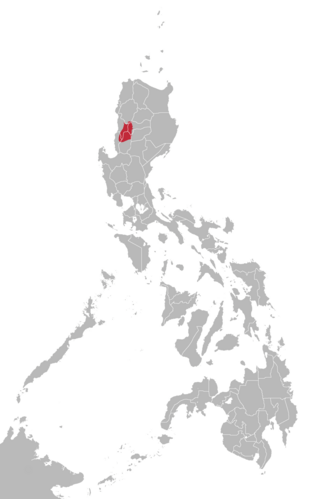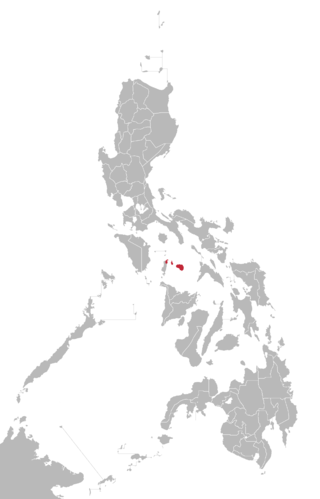
Ifugao, officially the Province of Ifugao, is a landlocked province of the Philippines in the Cordillera Administrative Region in Luzon. Its capital is Lagawe and it borders Benguet to the west, Mountain Province to the north, Isabela to the east, and Nueva Vizcaya to the south.

The indigenous peoples of the Cordillera in northern Luzon, Philippines, often referred to by the exonym Igorot people, or more recently, as the Cordilleran peoples, are an ethnic group composed of nine main ethnolinguistic groups whose domains are in the Cordillera Mountain Range, altogether numbering about 1.8 million people in the early 21st century.

Kankanaey is a South-Central Cordilleran language under the Austronesian family spoken on the island of Luzon in the Philippines primarily by the Kankanaey people. Alternate names for the language include Central Kankanaey, Kankanai, and Kankanay. It is widely used by Cordillerans, alongside Ilocano, specifically people from Mountain Province and people from the northern part of the Benguet Province. Kankanaey has a slight mutual intelligibility with the Ilocano language.

The Banaue Rice Terraces are terraces that were carved into the mountains of Banaue, Ifugao, in the Philippines, by the ancestors of the Igorot people. The terraces are occasionally called the "Eighth Wonder of the World". It is commonly thought that the terraces were built with minimal equipment, largely by hand. The terraces are located approximately 1,500 meters above sea level. These are fed by an ancient irrigation system from the rainforests above the terraces. It is said that if the steps were put end to end, it would encircle half of the globe.

Asipulo, officially the Municipality of Asipulo is a 5th class municipality in the province of Ifugao, Philippines. According to the 2020 census, it has a population of 15,963 people.

Hungduan, officially the Municipality of Hungduan is a 4th class municipality in the province of Ifugao, Philippines. According to the 2020 census, it has a population of 8,866 people, making it the least populated municipality in the province.

Kiangan, officially the Municipality of Kiangan is a 4th class municipality in the province of Ifugao, Philippines. According to the 2020 census, it has a population of 17,691 people.

Lamut, officially the Municipality of Lamut is a 4th class municipality in the province of Ifugao, Philippines. According to the 2020 census, it has a population of 26,235 people.

Mayoyao, officially the Municipality of Mayoyao is a 4th class municipality in the province of Ifugao, Philippines. According to the 2020 census, it has a population of 15,621 people.

The Rice Terraces of the Philippine Cordilleras are a World Heritage Site consisting of a complex of rice terraces on the island of Luzon in the Philippines. They were inscribed on the UNESCO World Heritage List in 1995, the first-ever property to be included in the cultural landscape category of the World Heritage List. This inscription has five sites: the Batad Rice Terraces and Bangaan Rice Terraces, Mayoyao Rice Terraces, Hungduan Rice Terraces and Nagacadan Rice Terraces, all in Ifugao Province. The Ifugao Rice Terraces reach a higher altitude and were built on steeper slopes than many other terraces. The Ifugao complex of stone or mud walls and the careful carving of the natural contours of hills and mountains combine to make terraced pond fields, coupled with the development of intricate irrigation systems, harvesting water from the forests of the mountain tops, and an elaborate farming system.

Ifugao or Batad is a Malayo-Polynesian language spoken in the northern valleys of Ifugao, Philippines. It is a member of the Northern Luzon subfamily and is closely related to the Bontoc and Kankanaey languages. It is a dialect continuum, and its four main varieties—such as Tuwali—are sometimes considered separate languages.

The Ifugao people are the ethnic group inhabiting Ifugao province in the Philippines. They reside in the municipalities of Lagawe, Aguinaldo, Alfonso Lista, Asipulo, Banaue, Hingyon, Hungduan, Kiangan, Lamut, Mayoyao, and Tinoc. The province is one of the smallest provinces in the Philippines with an area of only 251,778 hectares, or about 0.8% of the total Philippine land area. As of 1995, the population of the Ifugaos was counted to be 131,635. Although the majority of them are still in Ifugao province, some of them have moved to Baguio, where they work as woodcarvers, and to other parts of the Cordillera Region.

Ifugao State University (IFSU) is a government owned and funded university in the Philippines. It was originally established in 1920 as 'Nayon Settlement Farm School' by American educators. It gained its university status under Republic Act 9720 passed by the Philippine Congress and the Senate of the Philippines and duly approved in 2009 by Gloria Macapagal Arroyo, then President of the Republic. With the main campus in Lamut, Ifugao, it is mandated to offer course specializations on Agriculture, Forestry, Nursing, Social Sciences, Criminology, Teacher Education, Business Administration, Public Administration, Information Technology, Food Science, among others at undergraduate and graduate levels.

The Halsema Highway is a national secondary highway in the Philippines. Situated within the Cordillera Central range in northern Luzon, it stretches from the city limit of Baguio to the municipality of Bontoc. Its highest point is at 2,255.52 metres (7,400.0 ft) above sea level in the municipality of Atok. It was officially recognized as the highest altitude highway in the Philippines until 2019, when the 2,429 metres (7,969 ft) high point Kiangan–Tinoc–Buguias Road in Tinoc, Ifugao, was recognized as the new holder of the distinction.

Kalanguya, also called Kallahan, is a dialect cluster spoken by the Kalanguya people of northern Luzon, Philippines.

Romblomanon or Bisaya/Binisaya nga Romblomanon is an Austronesian regional language spoken, along with Asi and Onhan, in the province of Romblon in the Philippines. The language is also called Ini, Tiyad Ini, Basi, Niromblon, and Sibuyanon. It is a part of the Bisayan language family and is closely related to other Philippine languages.

Teodoro "Teddy" Brawner Baguilat Jr. is a Filipino politician and journalist, activist and advocate of indigenous peoples' rights and the rights of minority groups.

The Kiangan National Shrine also known as the Yamashita Shrine is a war memorial in Kiangan, Ifugao, Philippines. It commemorates the surrender of the top commander of Japanese Imperial Army in the Philippines General Tomoyuki Yamashita to the Allied forces, which led to the end of the Japanese occupation of the archipelago during World War II.

The Ifugao Provincial Board is the Sangguniang Panlalawigan of the Philippine province of Ifugao.

Nueva Vizcaya–Ifugao–Mountain Province Road or Nueva Vizcaya–Mountain Province Road signed as National Route 109 (N109) of the Philippine highway network, is a 104.52-kilometer (64.95 mi) national secondary road. It traverses and connects the municipalities of Bagabag in province of Nueva Vizcaya; Lamut, Kiangan, Lagawe, Hingyon and Banaue in the province of Ifugao. and Bontoc in the province of Mountain Province.



















